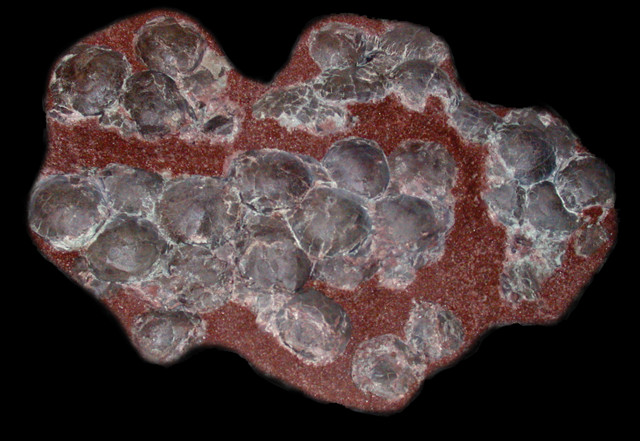
by Mary Caperton Morton Friday, January 8, 2016

A fossilized clutch of titanosaur eggs. Credit: Luis Chiappe.
Whether dinosaurs had metabolisms more like slow, cold-blooded reptilians or fast, warm-blooded birds has long been a mystery. Fossilized bones, which don’t preserve the delicate cell membranes that facilitate heat production in warm-blooded animals, are not likely to answer the question. Fossilized eggshells, however, might be just the ticket to determining the past body temperatures of egg-laying females, which, scientists say, might help address whether the dinosaurs’ metabolisms were warm or cold.
Reptiles, like lizards and crocodiles, are cold-blooded animals, or ectotherms, that are at the mercy of external heat sources to warm their bodies. These animals are usually confined to warmer climates where they absorb heat from sunlight. But dinosaurs’ widespread distribution across many climate zones suggests that they might have had higher body temperatures than modern-day reptiles, and scientists have long wondered whether dinosaurs were endotherms — more similar to modern-day birds than crocodiles.
To test the feasibility of calculating ancient dinosaur body temperatures from fossil eggshells, a team led by Robert Eagle, a geochemist at UCLA, measured carbon-13 and oxygen-18 isotopic ratios in eggshells from 13 modern bird species and nine species of reptiles using a mass spectrometer. The researchers determined the mineral formation temperatures recorded in the calcium carbonate of the eggshells, which matched up with the internal body temperatures of the mothers at the time the eggshells formed.
“We were able to quite clearly distinguish the birds from the reptiles and predict the known body temperatures to within 1 to 2 degrees Celsius,” Eagle says. “We were also able to distinguish among different species of birds,” he says, differentiating, for example, “small songbirds with high metabolisms from large flightless birds like ostriches.”
Next, the team turned to eggshells found in Argentina belonging to a large sauropod called Titanosaurus that lived about 80 million years ago, as well as shells from Mongolia that were laid by a small theropod called Oviraptor and dated to about 75 million years ago. “We picked these two species because fossil embryos had been found inside some of the eggshells, so we could assign a specific species to the eggshell,” Eagle says.
The team selected three well-preserved eggshells from each species and analyzed the shells’ chemistry to determine the temperature at which they’d formed. They found that the large sauropods were warm, roughly 37 degrees Celsius, while the smaller theropods were slightly cooler, about 32 degrees Celsius.
While this study, published in Nature Communications, presents some of the first direct body-temperature measurements for theropods, the sauropod results match up with findings from previously published work in which Eagle and colleagues measured isotopic ratios preserved in sauropod teeth. That work indicated that sauropods had body temperatures between 36 and 38 degrees Celsius. Modern mammals run between 36 and 39 degrees Celsius; reptile body temperatures vary widely, with crocodiles being between 26 and 37 degrees. Birds are typically warmer, closer to 40 degrees Celsius.
“These temperatures suggest that at least some species of dinosaur fell somewhere in between reptiles and modern birds,” Eagle says. “They were not full endotherms yet but they likely had faster metabolisms than reptiles.”
But not everyone agrees that eggshells are a reliable source of 80-million-year-old temperature data. “Body temperature is a problematic subject to study because it’s affected by many internal and external variables. It’s hard to find information that is solely dependent on temperature, and is not affected by other variables,” says Eva Maria Griebeler, a biologist at the Johannes Gutenberg University of Mainz in Germany, who was not involved in the new study. The isotopic ratios could have been altered over the time they were buried and may not accurately reflect the body temperatures of the females when the eggs were formed, she says.
Furthermore, Griebeler notes, studies on modern animals suggest that although isotopic ratios can sometimes provide records of body temperatures, they typically only reflect the body temperature during mineralization, which could be deceptively high in, for example, an ectothermic animal that warms itself in the sun. “A high temperature doesn’t automatically mean the animal was endothermic,” she says.
© 2008-2021. All rights reserved. Any copying, redistribution or retransmission of any of the contents of this service without the expressed written permission of the American Geosciences Institute is expressly prohibited. Click here for all copyright requests.